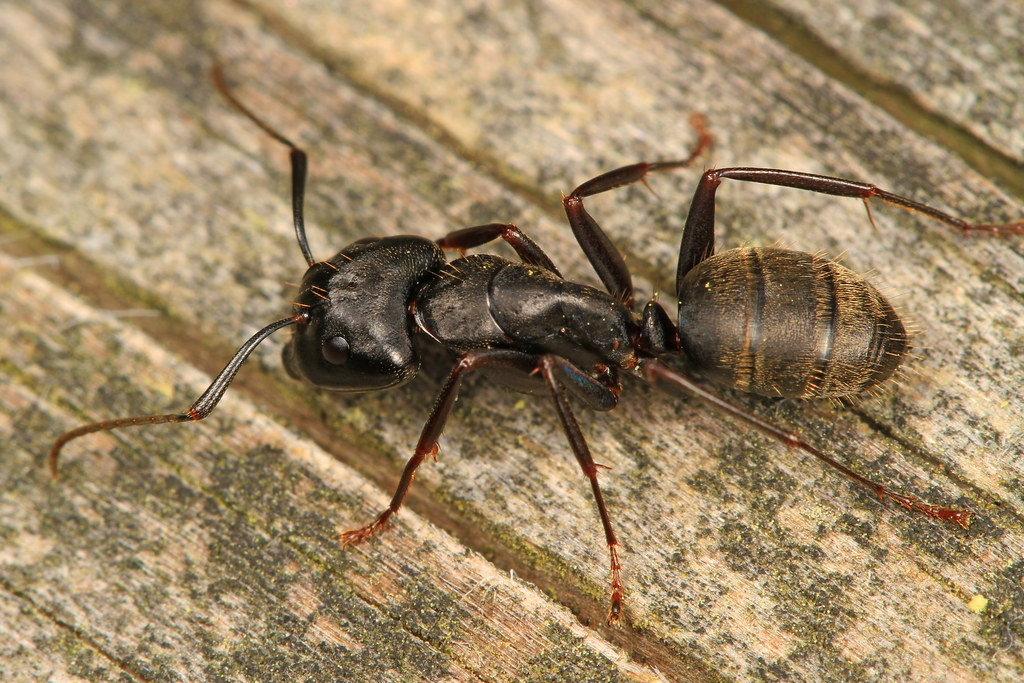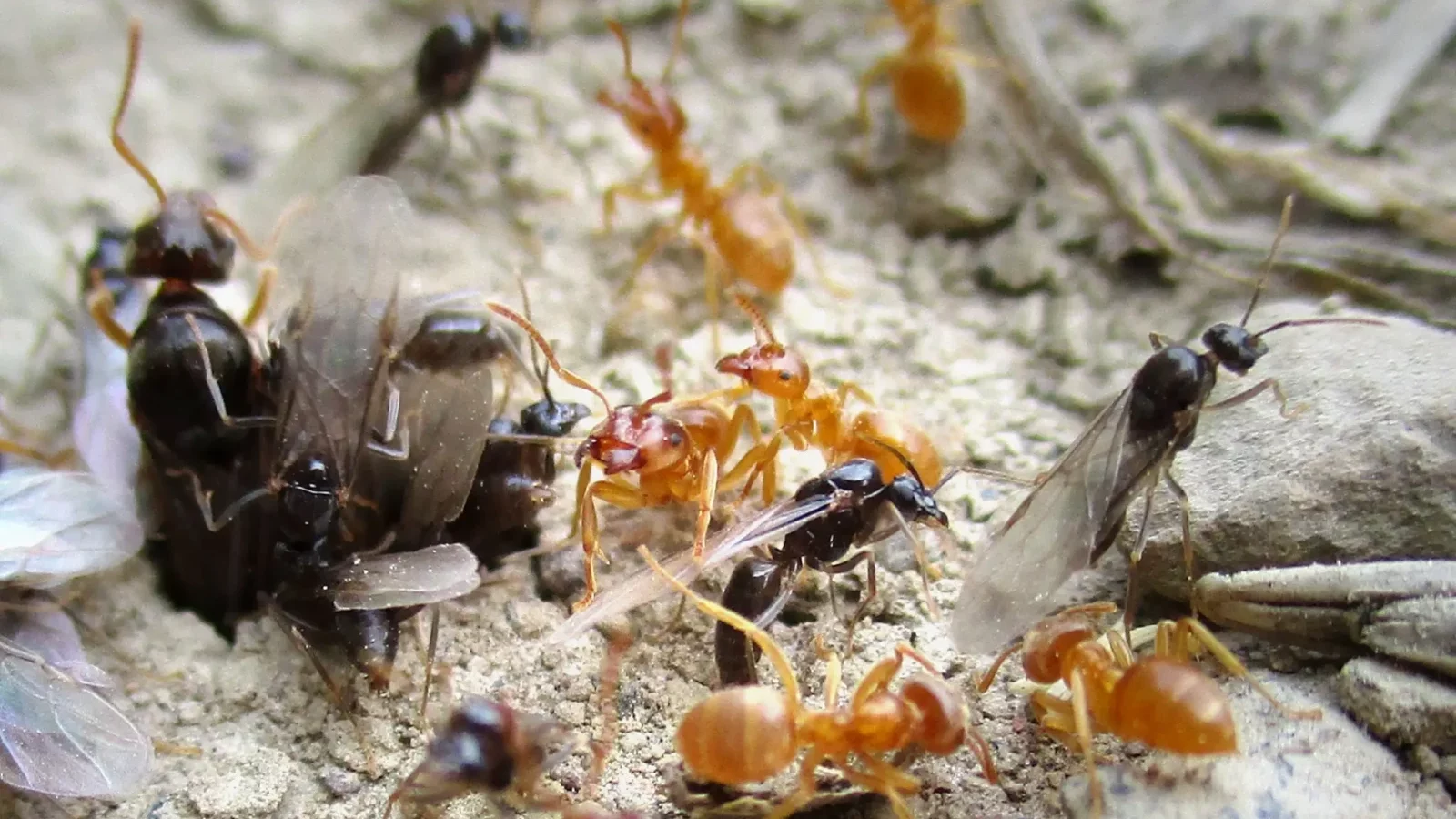Key Takeaways
-
Diverse Diet: Carpenter ants eat insects, plant matter, and human foods including sweets, proteins, and fats.
-
Wood Excavation, Not Consumption: They don’t eat wood—carpenter ants excavate it to create nests, which can damage structures.
-
Feeding Patterns: Active mainly at night, they use pheromone trails to forage up to 100 feet from their nests.
-
Signs of Infestation: Watch for sawdust debris, rustling inside walls, winged ants indoors, or foraging in kitchens and bathrooms.
-
Effective Prevention Strategies: Cleanliness, sealing food, reducing moisture, trimming plants, and bait traps help keep infestations away.
-
Common Myths Clarified: They don’t eat wood and need moisture—unlike the common myths about only liking sugar or dry environments.

What Do Carpenter Ants Eat?
Carpenter ants have a varied diet that includes natural sources like insects, plant matter, and human food. Below is a breakdown of their primary food sources.Animal-Based Foods
-
 Insects and Other Arthropods: Carpenter ants feed on live and dead insects, including beetles, caterpillars, and spiders.
Insects and Other Arthropods: Carpenter ants feed on live and dead insects, including beetles, caterpillars, and spiders. -
 Honeydew from Aphids: They consume the sugary secretion from aphids and other sap-feeding insects.
Honeydew from Aphids: They consume the sugary secretion from aphids and other sap-feeding insects. -
 Small Invertebrates: Occasionally, they prey on small invertebrates for protein.
Small Invertebrates: Occasionally, they prey on small invertebrates for protein.
Plant-Based Foods
-
 Fruits: They feed on overripe fruits that provide natural sugars.
Fruits: They feed on overripe fruits that provide natural sugars. -
 Plant Exudates: They consume tree sap and plant secretions.
Plant Exudates: They consume tree sap and plant secretions. -
 Nectar: They are attracted to the nectar in flowers.
Nectar: They are attracted to the nectar in flowers.
Human Food Sources
-
 Sugary Substances: They are drawn to sweets like honey, jelly, syrup, and candy.
Sugary Substances: They are drawn to sweets like honey, jelly, syrup, and candy. -
 Proteins: They consume leftover meats and pet food.
Proteins: They consume leftover meats and pet food. -
 Grease and Fats: These provide essential nutrients for their colony.
Grease and Fats: These provide essential nutrients for their colony.
Do Carpenter Ants Eat Wood?
One of the biggest misconceptions about carpenter ants is that they eat wood. In reality, carpenter ants do not consume wood; instead, they excavate it to create nests or galleries where they live. This behaviour can result in significant structural damage over time if left unchecked, but it’s important to understand that the ants are not feeding on the wood itself. The wood shavings they produce, often found in small piles around their nest entrances, resemble fine sawdust and are a tell-tale sign of a carpenter ant infestation. Carpenter ants prefer nesting in damp or rotting wood, as it is easier for them to tunnel through. Therefore, they are more likely to establish nests in wood that has been weakened by moisture or decay. This makes homes with leaky roofs, damp basements, or other sources of moisture particularly vulnerable. If you feel things have gone out of control, it is advised to contact pest control professionals. Our team can provide a customized approach to protect your home effectively.

Not getting a solution?
Get your free pest control estimate today!Feeding Behavior of Carpenter Ants
Carpenter ants are omnivorous, meaning they eat both plant and animal matter. They are opportunistic feeders and consume a variety of organic materials based on availability. Worker ants leave their nests at night to forage for food, often traveling long distances.Key Feeding Behaviors of Carpenter Ants
-
Carpenter ants search for food primarily at night.
-
They follow scent trails left by other ants to locate food sources.
-
Their diet consists mainly of proteins and sugars.
-
They do not eat wood but may tunnel through it to build their nests.
Foraging Behavior of Carpenter Ants
Carpenter ants have an organized system for finding and collecting food.- Scouting: Worker ants search for food sources and leave a pheromone trail for others to follow.
- Trail Formation: Once a food source is located, a steady stream of ants follows the trail to collect food.
- Mass Foraging: Large numbers of ants work together to transport food back to their colony.
- Long-Distance Travel: Carpenter ants travel far from their nests in search of food, sometimes covering over 100 feet.
Signs of a Carpenter Ant Infestation
Small piles of sawdust-like debris near wood structures are a very common sign of carpenter ant infestation. These are the wood shavings that carpenter ants produce when excavating their galleries. Another sign is the appearance of winged ants, especially indoors, which typically occurs when a colony matures and begins to reproduce. You may also hear faint rustling noises coming from within walls or wooden beams, especially at night when the ants are most active. If you see carpenter ants foraging inside your home, particularly in kitchens or bathrooms, this could be a sign that a nest is nearby.
How to Prevent Carpenter Ant Infestations
Since carpenter ants are attracted to food sources, keeping them away requires proper sanitation and home maintenance.Prevention Tips for Carpenter Ants
-
Keep Food Sealed: Store sugary and protein-rich foods in airtight containers.
-
Clean Spills Immediately: Wipe down surfaces and sweep crumbs to remove food sources.
-
Eliminate Moisture: Fix leaks and reduce humidity to make your home less attractive to ants.
-
Trim Vegetation: Keep tree branches and shrubs away from your home to prevent ants from entering.
-
Use Bait Traps: Carpenter ant baits can help control their population effectively.
Myths vs. Facts: Carpenter Ants’ Food
Here are a few myths and facts about carpenter ants:| Myths | Facts |
|---|---|
| Carpenter ants eat wood. | They tunnel through wood but don’t consume it. |
| They only eat sugary foods. | They eat proteins, fats, and sugary substances. |
| They don’t need water to survive. | They need moisture and often seek water sources. |
| They hunt and kill other insects for food. | They scavenge dead insects but don’t actively hunt. |
| They only feed at night. | They forage both day and night, depending on conditions. |





